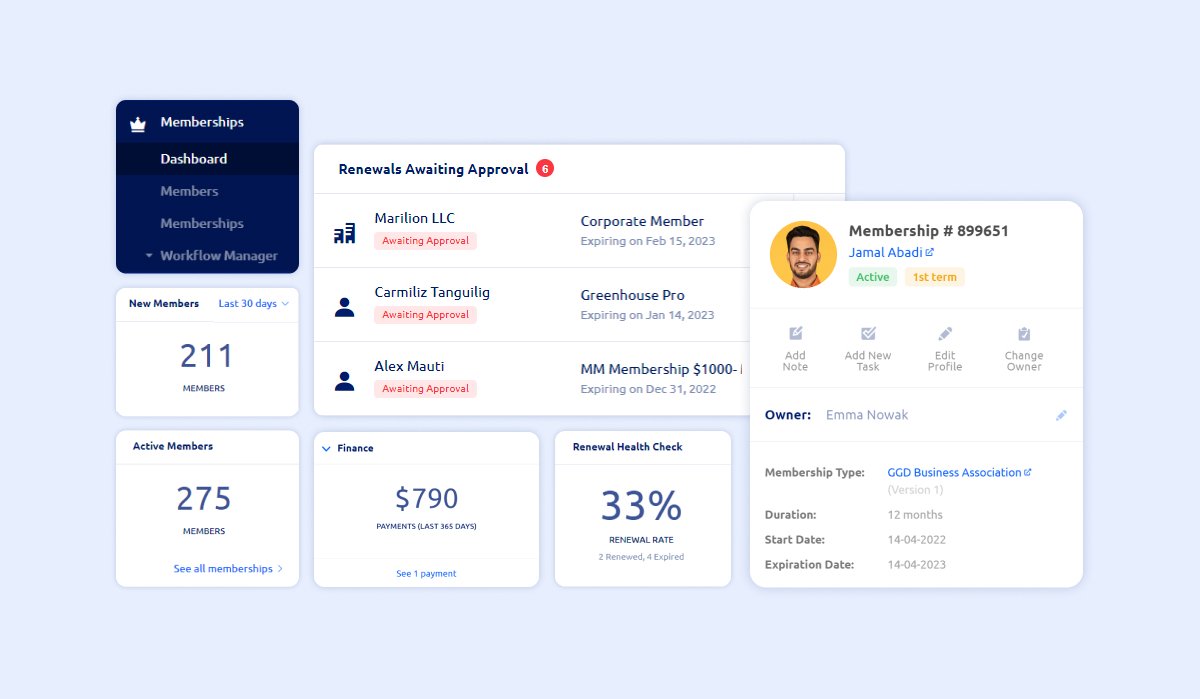
Organizations worldwide operate in a business environment marked by constant and disruptive change.
Megatrends, including technological transformation and demographic shifts, are reshaping industries and redefining the needs of business communities.
As you develop your organization's strategic plan, you should consider the key challenges and opportunities to determine how your chamber should respond.
Continue reading to discover these major trends and take a proactive approach to stay ahead of the curve and utilize change to benefit your members.
Key Takeaways
- AI and automation are significantly transforming business processes, enhancing efficiency, and enabling advanced member services. The adoption of AI can lead to more informed decision-making and digital transformation.
- The increasing adoption of cloud technology presents an opportunity to improve efficiency and agility.
- The changing landscape of global trade, with a shift towards localized networks, will require you to assist members in navigating new market opportunities, trade compliance, and understanding emerging trade policies.
- The blurring of industry boundaries due to digital transformation creates both challenges and opportunities. You can facilitate cross-industry collaboration and innovation, helping your members adapt and remain competitive in this evolving business environment.
1. AI and Automation

Artificial intelligence and automation are revolutionizing industries across the globe, and chambers of commerce are no exception.
As these technologies integrate seamlessly into various sectors, they are expected to transform 50% of all business processes within the next few years.
This change presents a unique opportunity for you to adopt AI-driven solutions, automate routine tasks, enhance operational efficiency, and offer AI-enhanced offerings to your members.
According to a PwC estimate, AI might contribute up to $15.7 trillion to the global economy by 2030.
AI and automation not only streamline your business processes but also provide insights and predictive analytics, enabling more informed decision-making.
Thus, they present a unique opportunity to digitize your offerings through:
- Digital networking opportunities
- AI-enabled services
- Data-driven strategies
- Virtual events, and
- Digital transformation support to your members
2. Adoption of Cloud Technology
Cloud adoption grew over 30% in 2022, with over 90% of enterprises now using some form of cloud services.
As per Flexera's 2023 State of the Cloud Report, organizations spending on public cloud is expected to grow over 20% this year to $122 billion.
As a chamber leader, you cannot ignore this megatrend.
Cloud technology enables greater efficiency, cost savings, and business agility. However, migrating to the cloud can be complex, especially if you dont get enough support during onboarding.
You need an adoption strategy that works for your unique business needs. Thus, we recommend you to:
- Approach cloud adoption in phases.
- Prioritize migrating non-critical systems first to test processes before moving essential systems.
- Work closely with cloud providers to optimize configurations for performance, security, and cost.
- Train employees on using cloud tools to drive user adoption.
If you’re unsure how to migrate your data to a cloud technology, you can contact us experts here and receive expert advice.
Thus, with careful planning and execution, you can leverage the cloud's potential to gain a competitive advantage.
The cloud shift is here to stay - ensure your business is ahead of the curve.
How to Find The Right Cloud Technology That Integrates AI and Automation?

It's imperative to find the right cloud technology that integrates both AI and automation to stay updated for the digitalized future.
Glue Up is the first cloud technology that has combined both AI and automation for chambers. The platform offers a secure infrastructure and is scalable for your various business needs.
Additionally, with its robust analytics and powerful dashboards, you can make data-driven decisions, while its automation features reduce manual workload, improving overall productivity.
The security of its cloud infrastructure ensures data integrity and compliance with industry standards, making it a reliable and forward-thinking choice for businesses seeking to harness the power of AI and automation in the cloud.
For more information about the tool and to experience it firsthand, you can click here to get a demo.
3. Climate Change and Sustainability

With rising stakeholder expectations on environmental sustainability, you can guide and support members in their net zero transitions with sustainability strategies, emissions measurement tools, and clean energy adoption roadmaps.
According to the United Nations Environment Programme, global greenhouse gas emissions need to be cut by 7.6% every year from 2020 to 2030 to meet the 1.5°C temperature goal of the Paris Agreement.
You can also advocate for supportive policy frameworks that incentivize renewable energy and energy efficiency investments. For example, offering grants and tax breaks for companies that install solar panels or improve insulation.
As a chamber leader, you are in a unique position to lead climate action and create resilient, future-facing business communities.
4. Evolving Global Trade Dynamics

The global trade value reached a record $32 trillion in 2022, as reported by the United Nations Conference on Trade and Development (UNCTAD). However, the evolving trade dynamics are leading countries to re-evaluate trade relationships.
Regional partnerships like the United States-Mexico-Canada Agreement (USMCA) and the African Continental Free Trade Area (AfCFTA) signal a shift toward more localized trade networks.
As the global trade landscape evolves, you have an important role to play.
You can provide export assistance to help members access new markets.
For example, you might connect companies with foreign buyer delegations or advise on documentation requirements.
Additionally, you can identify growth opportunities in areas like digital trade and sustainability. Helping members navigate trade compliance issues will also be key, whether due to changing tariffs, rules of origin requirements, or banned entity lists.
You can offer tailored services to help businesses succeed globally by monitoring trade policy developments and understanding members' needs.
This support will be vital as companies adapt to new trade realities in the years ahead.
5. Industry Convergence
Industry convergence is accelerating, with over 90% of companies reporting some impact from blurring sector boundaries.
As digital transformation reshapes business models, unexpected competitors can disrupt entire industries. However, new partnerships will also form across converging sectors.
Being a chamber leader, you are uniquely positioned to facilitate cross-industry exchange and support your members through both the threats and opportunities of convergence.
For example, you could host events, workshops, or working groups that bring together companies from different industries to brainstorm ideas for new products, services, and business models.
This kind of collaborative innovation is key to remaining competitive amid industry convergence.
You might also provide training and resources to help members understand convergence trends in their sector and adapt their strategies accordingly.
Most importantly, you can serve as a trusted advisor to guide members through uncertain times of change.
6. Talent Shortages
The global skills gap continues widening even as lifelong learning becomes imperative for the future workforce.
A recent OECD report found that talent shortages have tripled over the past decade, with over 40% of employers reporting difficulty filling positions.
Due to your unique position, you have the opportunity to understand talent needs across your business community.
- You can lead upskilling initiatives, like coordinating training programs tailored to your region's workforce gaps.
- Provide HR and recruitment support services, like job fairs and applicant screening.
- Support talent development locally to retain workers, attract new residents, and enable businesses to remain competitive.
- And partner with local education institutes to align curriculums with the competencies employers seek.
With proactive collaboration, you can equip workforces with the ever-evolving skills that this digitalized world demands.
7. Data Utilization

Many small companies still lack the tools and talent needed to fully capitalize on their data.
Thus, you can provide valuable guidance to help members develop data strategies and find accessible analytics tools. For example,
- You might curate a list of easy-to-use, affordable software options for collecting, visualizing, and making sense of data.
- You could also organize training sessions and peer roundtables for members to learn best practices around data privacy, ethics, and governance - topics that many small business leaders struggle with.
As business becomes more insight-driven, equipping your members with data utilization capabilities will allow them to compete effectively. It also enables you to better understand member needs and design targeted services.
Lean into your role as a data advisor and conduit, but stay cognizant of potential ethical pitfalls. Approach data as an opportunity to responsibly equip businesses, not overwhelm them.
8. Shifting Social Values
According to a recent report by the Global Web Index, 67% of consumers say their purchasing decisions are influenced by a company's social positions and values.
- Advise your members that aligning business practices with emerging social values in their communities is key for reputation management and talent retention.
- Host roundtable discussions for members to exchange ideas on implementing eco-friendly operations, diversity and inclusion initiatives, community partnerships, and other programs reflecting local social values.
- Highlight members already leading in these areas as role models. Publish best practice guides on your website.
- Offer networking events connecting members with local nonprofits and community leaders to build an understanding of pressing social issues.
Consulting services assisting members in conducting surveys and focus groups to solicit stakeholder input can uncover disconnects between internal and external perceptions that may impact consumer loyalty if unaddressed.
Keeping a pulse on shifting community expectations and guiding members to proactively address them will build goodwill and make your area more attractive to conscientious talent and consumers alike.
9. Catalytic Leadership
Being a chamber leader, you face growing complexity and uncertainty in guiding your organization.
Rapid technological advances, economic shifts, and social changes create both risks and opportunities. So, how can you provide steady leadership amidst this turbulence?
Catalytic leadership holds the key to the solution.
Like a catalyst that speeds up chemical reactions, catalytic leaders drive change by inspiring others from within. They connect people to a higher purpose and empower them to adapt and innovate.
A study by EY US Consulting highlighted the importance of empathy in leadership. It found that 86% of employees believe empathetic leadership boosts morale, and 87% say empathy is essential for fostering an inclusive environment.
To prepare your chamber for the future, focus less on control and more on trust.
Allow for failure on the path to innovation. And frame challenges as opportunities for growth that engage your entire community.
Leading your chamber into the disruptive decade ahead with purpose, agility, and collective impact is possible when you model the change you wish to see.
With these megatrends in hand, you'll remain integral partners during the volatility that lies ahead. You can empower local enterprises to compete and thrive during disruptive change through upskilling, digital adoption, and sustainable transformation.
For more information on navigating these key trends and staying ahead with the latest technology, please feel free to contact our team here or download our ebook.



